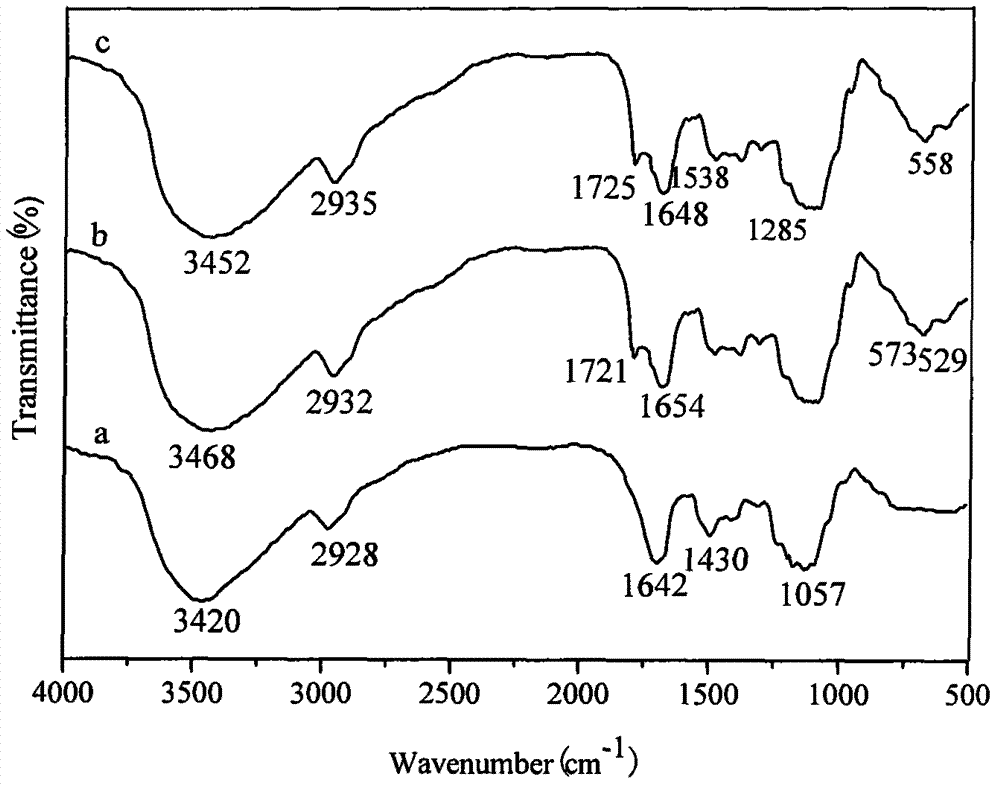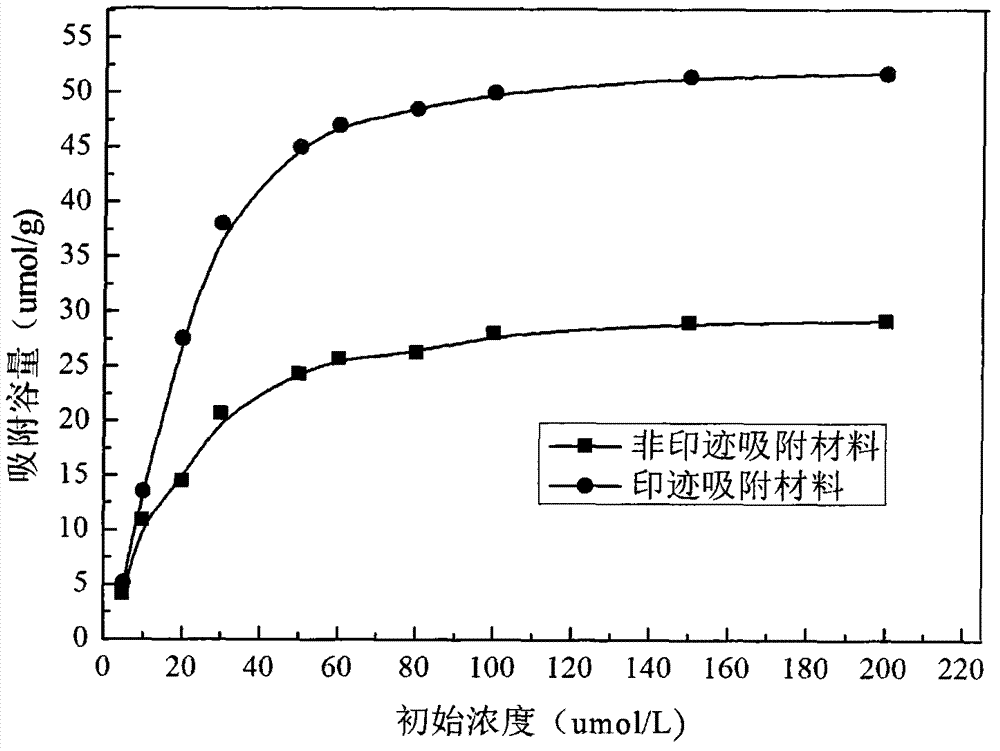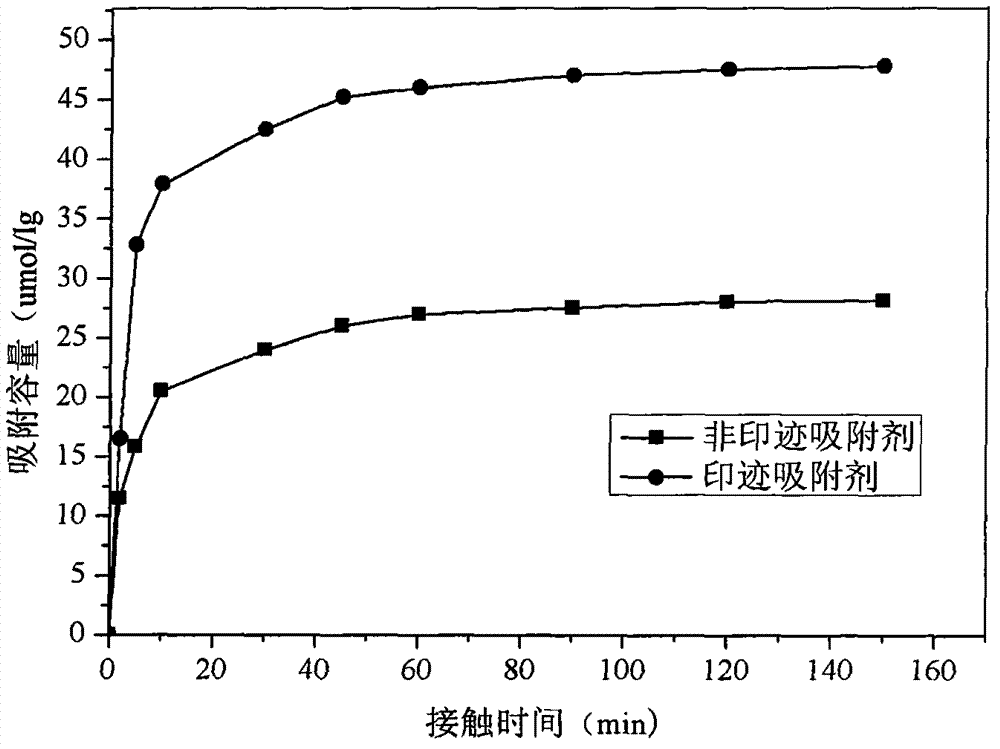Preparation method of chloramphenicol molecular imprinted adsorbing material on surface of magnetic carbon microsphere
An adsorption material and molecular imprinting technology, which is applied in the direction of analytical materials, selective adsorption, chemical instruments and methods, etc., to achieve high selectivity, low cost and fast adsorption speed
- Summary
- Abstract
- Description
- Claims
- Application Information
AI Technical Summary
Problems solved by technology
Method used
Image
Examples
Embodiment 1
[0024] (1) Preparation of magnetic carbon microspheres
[0025] Take the pomelo peel that has been cleaned of impurities on the inner and outer surfaces, cut it into small sections with a length and width of 2-10 cm, and dry it at 100°C for 24 hours to obtain dried grapefruit peel; press ferric nitrate nonahydrate, the dried grapefruit peel prepared above and ethanol Mix at a ratio of 1:1.5:200 (g / g / mL), ultrasonically disperse evenly, stir magnetically at room temperature for 20 hours, and dry in an oven at 60°C; then soak in propionic acid vapor at 80°C for 16 hours; then put the mixture In a tube furnace under a nitrogen atmosphere, the temperature was raised to 500°C at 5.0°C / min, and the temperature was maintained for 2.0h for calcination. The calcined product was washed with ethanol several times, and dried to constant weight to obtain magnetic carbon microspheres.
[0026] (2) Vinyl modification on the surface of magnetic carbon microspheres
[0027] According to magne...
Embodiment 2
[0034] Take 25ml of CAP solutions with initial concentrations of 5, 10, 20, 30, 50, 60, 80, 100, 150, and 200 μmol / L, respectively, and add them to centrifuge tubes, and add 10 mg of molecularly imprinted adsorption materials on the surface of magnetic carbon microspheres and non- Imprint the adsorption material, put the test solution in a 25°C water bath and let it stand for 12.0h, separate and collect the supernatant with a Nd-Fe-B permanent magnet, and measure the molecular concentration of unadsorbed chloramphenicol with a UV-visible spectrophotometer , to calculate the adsorption capacity, figure 2 The results show that the imprinted adsorption material has a saturated adsorption capacity of 51.85umol / g, which is higher than that of the non-imprinted adsorption material, which is 25.20umol / g, which proves that the imprinted adsorbent has a large number of imprinted holes and shows a good imprinting effect.
Embodiment 3
[0036] Take 25ml of CAP solution with an initial concentration of 100μmol / L and add it to a centrifuge tube, add 10mg of magnetic carbon microsphere surface molecularly imprinted adsorption material and non-imprinted adsorbent material, and place the test solution in a water bath at 25°C for 2 and 5 minutes respectively. , 10, 30, 45, 60, 90, 120 and 150min, after standing still, the supernatant was separated and collected by Nd-Fe-B permanent magnet, and the molecular concentration of unadsorbed chloramphenicol was measured by UV-visible spectrophotometer , to calculate the adsorption capacity from image 3 It can be seen that at the beginning, with the increase of adsorption time, the adsorption capacity increased rapidly, and the adsorption reached equilibrium after 30 min. In the whole adsorption time range, the adsorption capacity of magnetic molecularly imprinted adsorbents for chloramphenicol molecules was greater than that of non-imprinted adsorbents for chlorine Mycin...
PUM
| Property | Measurement | Unit |
|---|---|---|
| Saturated adsorption capacity | aaaaa | aaaaa |
Abstract
Description
Claims
Application Information
 Login to View More
Login to View More - R&D
- Intellectual Property
- Life Sciences
- Materials
- Tech Scout
- Unparalleled Data Quality
- Higher Quality Content
- 60% Fewer Hallucinations
Browse by: Latest US Patents, China's latest patents, Technical Efficacy Thesaurus, Application Domain, Technology Topic, Popular Technical Reports.
© 2025 PatSnap. All rights reserved.Legal|Privacy policy|Modern Slavery Act Transparency Statement|Sitemap|About US| Contact US: help@patsnap.com



